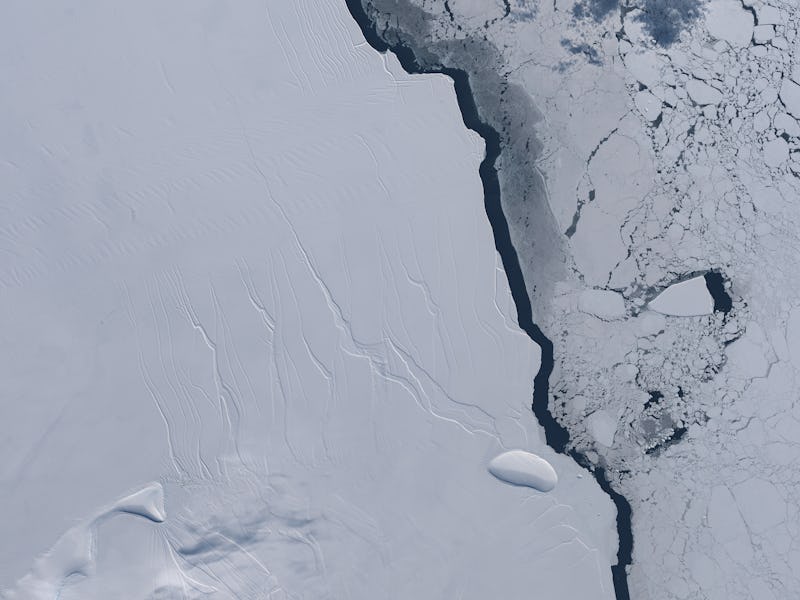An Iceberg the Size of Delaware Is About to Be Born in Antarctica
One of Antartica's largest ice shelves is very, very pregnant.

The calving of one of the biggest icebergs ever seen is imminent. Scientists anxiously observing Antarctica’s Larsen C ice shelf have noted a dramatic increase in the speed that the ice moving out towards the ocean. The crack is widening by a whopping 33 feet per day.
The ice shelf has a surface area as big as Vermont and New Hampshire combined. When the iceberg calves — and it will, soon — the shelf will lose more than 10 percent of its area. The chunk is about the size of Delaware, which is 2,491 square miles.
Right now, the crack between the berg and the main shelf is more than 110 miles long, with less than eight miles to go before the whole thing breaks free. It could be hours, days, or weeks until the rift is complete, Martin O’Leary and Adrian Luckman of Project MIDAS announced on Wednesday.
The free end of the iceberg has increased its speed threefold over the past few days and is now moving out towards the Antarctic ocean at an unprecedented rate. That shift must be putting an enormous amount of pressure on the remaining section of ice that still ties the berg to the shelf. The direction of the crack front has also recently shifted so that it’s now pointing almost straight to the ocean — another sign that the calving event could happen at any moment.
The calving event itself will be hard to watch in real time, as it’s the middle of the Antarctic winter, and the sun won’t rise over the continent for months. The scientists are monitoring the situation with the help of radar data from the European Space Agency’s Sentinel-1 satellites, which use microwaves to track ice movement.
If they could capture the event on video, it will resemble the drift of an enormous boat suddenly untethered from its mooring. The ice shelf is already floating, and when the rift reaches the ocean the iceberg will simply begin to float away.
The big question is not what will happen to the liberated ice — that’s going to float away and melt — but what this means for the ice shelf. Scientists suspect that this calving event could destabilize the entire shelf, leading the whole thing to collapse into the ocean over the coming years. This would be a dramatic change to Antarctica’s landscape and would contribute significantly to global sea level rise, as there would be nothing left to slow the flow of the glacier ice behind the shelf into the ocean.
Similar ice shelf collapses were witnessed at the Larsen A and Larsen B ice shelves, in 1995 and 2002, respectively. Larsen B collapsed in a matter of weeks, initiated by an iceberg calving event similar to the one that’s about to occur.
But Larsen C is many times bigger than its neighbor, and scientific debate continues over whether or not a total collapse will follow this calving event. It could be that the ice shelf simply grows back, as is the normal course of events for Antarctic ice shelves, which can keep them stable over millions of years.
But we’re not living in normal times. Research suggests that the whole ice shelf is thinning from above and below as both air and water temperatures climb because of climate change. When this piece of the shelf breaks off, it will expose new weaknesses in the ice behind, and the whole thing could destabilize. Signs of destabilization behind the rift have already been seen.
What happens at Larsen C — the fourth-largest ice shelf on the continent — will help scientists better understand how Antarctica will respond to climate change. This has major implications for predictions of future sea level rise, which threatens coastal cities and island nations worldwide. If global warming sets off a chain of events that destabilize Antarctica’s largest ice shelves, the consequences will be irreversible and devastating.